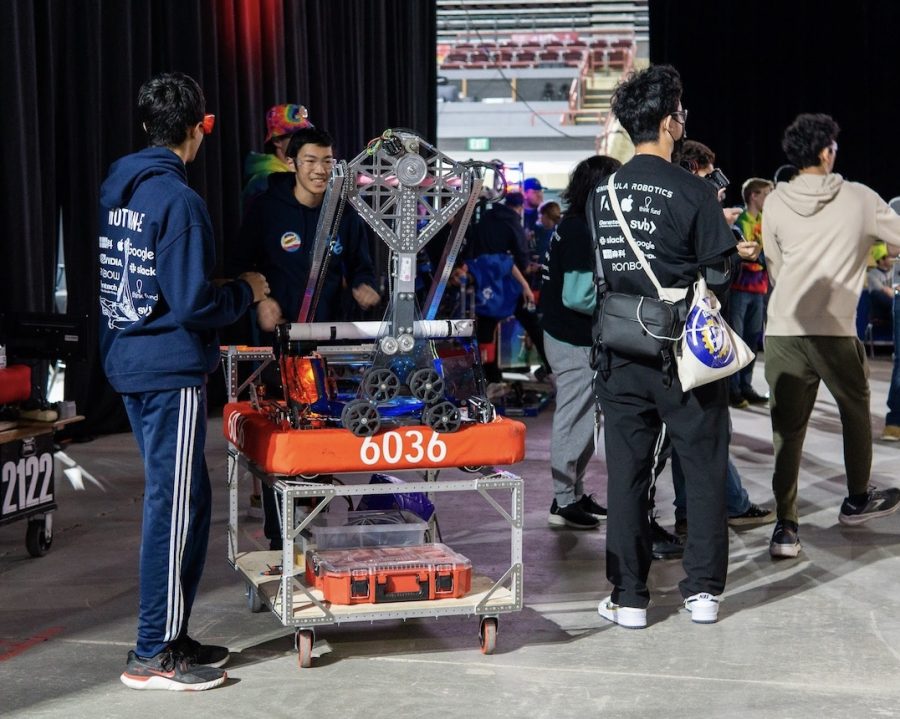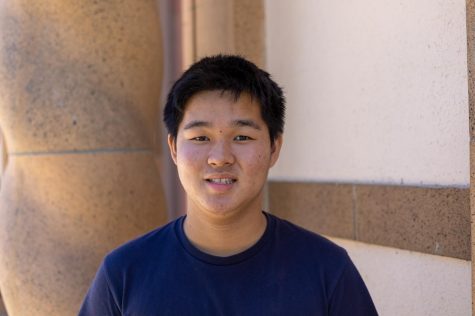Robotics team prepares for World Championships
Peninsula Robotics team members wheel their robot into the loading zone prior to a match during the Idaho Regional. Although the team won the regional, they had already secured a bid a week earlier at the Arizona East Regional to go to the FIRST Robotics World Championships. According to software captain Ashray Gupta, a challenging part of build season was ensuring involvement from every individual team member. “Part of build season was figuring out how to organize people, how to get people engaged, how to involve as many people as possible in like the stuff that we have to offer,” Gupta said. “We pride ourselves in being an open-door team, where anyone can do whatever they’d like in STEM.” (Photo: Ethan Sa)
April 17, 2023
With drills whirring and fingers flying across keyboards, the local FIRST Robotics team, Peninsula Robotics team 6036, is preparing to compete from April 19 to 22 in the Archimedes Division of the FIRST Robotics Competition World Championships in Houston.
The team— which is not affiliated with Palo Alto High School despite a large majority of members being students — secured a ticket to the World Championships after winning the Arizona East Regional, despite starting the competition season off with a close loss during the finals round at the Hueneme Port Regional. The team then went on the win again at the Idaho Regional two weeks after the Arizona East Regional.
According to mentor Andrew Hodge, the ability of the team to work under constraints was what made their success especially notable.
“It’s really amazing to see a small group of students and mentors with limited resources working out of a two-car garage and then building a super simple, efficient robot,” Hodge said. “There’s definitely some great robots out there, but you need to be a team with a lot more resources to build the far more complicated things.”
The team attended three regionals instead of the usual two, a decision Software Captain Ashray Gupta said was motivated by the hope to learn and improve.
“We went to three competitions this year as opposed to two that most teams usually do because we really wanted to learn from every competition,” Gupta said. “So we would have that [the experience] for the next competition and just do much better and better until we got to championships.”
According to Gupta, the time in between competitions is spent making a variety of modifications, both to the software and hardware aspects of the robot, in order to best prepare their robot for the next competition.
“Most of the hardware [iterations] actually happen before competitions, but a lot of the software changes that happen between competitions are dependent on new strategies that we want to play with,” Gupta said. “Between competitions, we write new autonomous functionality [code]. [Making] stronger parts is something that we learned this season, and making a more durable, robust robot because reliability is the name of the game.”
In preparation for championships, Gupta said the team is focusing on fine-tuning the robot in terms of speed and consistency.
“We’re making a lot of things much faster physically on the robot itself,” Gupta said. “We’re making things a lot more reliable because, especially at championships, reliability just matters so much; one bad match out of 12 and you can lose the whole thing.”
According to Build Co-Captain Amol Tandon, time management has been an especially difficult challenge throughout the competition season.
“It has been hectic because we’ve been in the competition every other weekend for all of March and then we’re going to champs next week,” Tandon said. “A lot of the team members are juniors, so a lot of us are really busy at school. We really only have a week between competitions. So it becomes a game of just time management and how we choose to split it up of maybe a few days of build and design just to get those iterations like for robustness.”
In terms of technical challenges, Tandon said they encountered challenges with the arm mechanism’s functionality.
“We’ve had a lot of issues with it breaking so we went through four versions of the arm,” Tandon said. “We’ve had a lot of things shearing, a lot of things breaking with the amount of torque and force going through it. But through competitions and just through all the testing we’ve been able to do with the field has ironed out all those issues.”
However, building a robot in addition to implementing numerous revisions requires substantial funding, which Gupta said often comes from community donations. The team is striving to meet a goal of 10,000 dollars in order to cover the expenses needed to attend the World Championships.
“The amount of iteration that we do especially is what makes it so expensive,” Gupta said. “This space [the practice field] actually cost a lot of money, a lot of parts cost a lot, food, travel, all that sort of stuff costs so much. The GoFundMe was especially important because flights are incredibly expensive.”
Hodge said the team members’ shift in confidence and mentality has been especially exciting to watch.
“It’s been really neat to see some of the students go from wearing other people’s T shirts and being envious of other people’s robots to realizing ‘oh, wow, our simple, super fast robot is really amazing’ and having some pride in that,” Hodge said.
Peninsula Robotics will compete in the Houston Championships from April 19 to 22, with a livestream available at The Blue Alliance. The team’s GoFundMe can be accessed here.










![A protester in a chicken suit wearing a taco hat with the words “Cluck Trump” at the “No Kings” Democracy Fair in Palo Alto on Saturday. Protestor Mary Chan said she and her husband are horrified at the state of science and medicine in America. “What he [Trump] is doing by defunding scientific research is destroying our academic medical centers, and he’s [Trump] bankrupting rural medical centers,” Chan said. “We will have lasting negative impacts on American health for decades.”](https://palyvoice.com/wp-content/uploads/2025/10/11562FFE-9912-4152-BB01-582426B52ECB_1_105_c-225x300.jpeg)